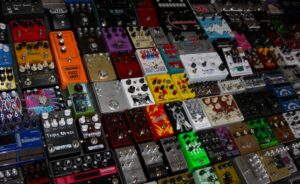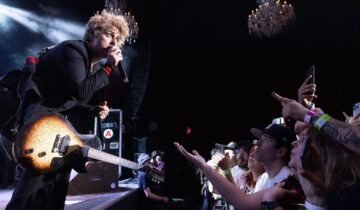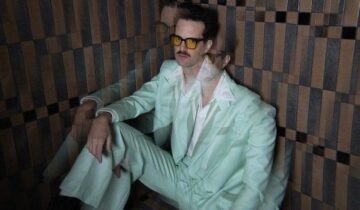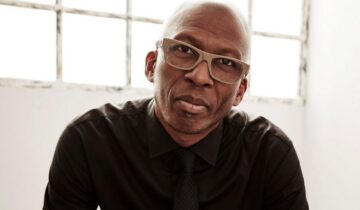Story by Gary Moskowitz for Reverb on November 2, 2023
 Brass and woodwind players are expected to play lines: melodic phrases that help define the identity, style, and vibe of a song. Horn players are also expected to take solos that help elevate the energy and mood of the song, and harmonize with each other to add texture and musicality. That’s the job: support the music by doing things horns are designed to do.
Brass and woodwind players are expected to play lines: melodic phrases that help define the identity, style, and vibe of a song. Horn players are also expected to take solos that help elevate the energy and mood of the song, and harmonize with each other to add texture and musicality. That’s the job: support the music by doing things horns are designed to do.
But what happens when you pair brass instruments with electric instruments running through effects pedals? There are limitations to what horn players can do because they’re playing an acoustic instrument with their face: how can a pair of lips keep up with heavy amounts of voltage and wattage? It’s like running a marathon next to someone riding an e-bike.
Horn players can’t match those same levels of tonality and output, unless of course they plug their microphone into those same types of effects pedals. Armed with guitar effects, horn players can move beyond lines, solos, and harmonies to provide more sounds, voicings, and layers to songs.
Processed horns can easily sound cheesy or pretentious, and they can make more work for sound engineers because open microphones are prone to feedback. But horn players with properly organized pedal boards say they can become sonic sculptors that stand on equal footing with electric instruments and add more value to what the band is trying to accomplish.
This is not a new concept. In 1966, saxophonist Eddie Harris began playing with the Varitone, a woodwind pickup and effects unit that allowed Harris to add delay, octave doubling, and wah to his playing. Trumpeter Miles Davis, inspired by Sly and The Family Stone, Jimi Hendrix, and James Brown, famously began running his trumpet through a wah pedal in live performance and on early 70s recordings like “Bitches Brew” and “Live Evil.”
“I was using the wah wah on my trumpet all the time so I could get closer to that voice Jimi had when he used a wah wah on his guitar,” Miles Davis wrote in his autobiography. “I had always played trumpet like a guitar and the wah wah just made the sound closer.”
Sonny Stitt and Wayne Shorter experimented with altering the sound of their horns, as did the Brecker Brothers in the 70s. Seamus Blake used effects on his saxophone in the mid-’90s grunge-jazz band the Bloomdaddies and Eddie Harris tribute shows, and sax player Skerik has incorporated electronic effects into his work with bands like Critters Buggin, Garage A Trois, and Dead Kenny G’s since the 90s.
Reverb recently spoke with a handful of professional horn players about how and why they use a variety of effects pedals for recordings and live performance.
Doug Levin
Saxophonist and co-founder of HornFX, a company that educates horn players on guitar effects
Doug Levin’s parents loved music and always had it on when he was growing up. They taught him to listen to music not like a fan, but like a musician. When he was 13, he played sax with the Manhattan Transfer. He grew up with guitars in the house, and was fascinated with effects, so he plugged a wah pedal into his saxophone as a teenager just for fun. The result: feedback. But Levin was listening to a lot of the Brecker Brothers and wanted to have that sound, so he became obsessed with figuring it out.
Levin plays sax with groups in the Dallas area, like The Grays (funk fusion), YOG (Balkan-Gypsy-funk-metal), and Thugalicious (funk-R&B-metal), and plays with the funk-jazz-hip-hop band Ghost-Note when they’re in town.
“I’m still figuring it out, but [effects pedals] essentially became the DNA of me as a musician,” Levin says. “Now I’m not just a sax player, I’m a producer onstage with sax as a main tool. I play with hip-hop bands, I play metal. I can always add something, and do what the music requires.”
Horn players are taught to play with other horn players, so Levin has tried to turn himself into a one-man horn section. Early on, he experimented with an Electro-Harmonix Nano Pog polyphonic octave generator pedal, then a Source Audio Stingray multi-filter. “I would just go to Guitar Center with a mic and a speaker for hours and play every pedal in the building,” Levin says.
Now Levin uses an link text Eventide H9 multi-effects pedal, a Line 6 HX Stomp multi-effects pedal for layering, a Source Audio C4 synth and envelope filter pedal, and the RJM Mastermind LT MIDI controller to change settings on all the pedals. He uses synth sounds for leads and melodies and solos, uses harmony to sound like a horn section, and a lot of textural stuff: big reverberating fuzzy sounds, and heavy distortion to play metal.
“I feel kind of naked without my pedals, like I’m missing something, which is probably not a good thing, but using pedals is super fucking fun,” Levin says.
Levin and Horn-FX co-founder Aaron Janik now teach classes on horn effects at Berklee College of Music and USC, have written textbooks on the subject, and post loads of video tutorials.
Eric “Benny” Bloom
Trumpeter for Lettuce
When he plays live shows with Grammy-nominated funk band Lettuce, Bloom loves to use the detune chorus function on his DigiTech Whammy pitch shift pedal to play octaves and chords, and the pedal provides a fun warble effect without getting too crazy. With a reverb pedal on — not too wet, so you can clearly hear what he’s playing — he likes to double up on bass lines and comp, like he’s a rhythm section player. He doesn’t like a lot of phaser or flange, but loves the wah pedal. Everything plugs into a JHS Colour Box preamp.
“That detune chorus on the Whammy is very dope. Everyone used it in the 70s, like The Brecker brothers and John Scofield. I love that sound,” Bloom said.
Bloom, 42, started playing trumpet at 11, started taking private lessons in eighth grade, and got serious around 15 or 16. Outside of Lettuce, he’s played with Soulive, Pretty Lights, and Gramatik, and has done shows with Solange Knowles, Wu Tang Clan, Chaka Khan, and others.
Years ago, Bloom decided he wanted something to help boost his signal, but also wanted the same options for solos that the guitar players had. So he started investigating pedals. “When I stop playing a note, the note stops. But on guitar or keys, when you play one note it rings out, and can have textures, and create all these cool things,” Bloom says. “Trumpet is one sound the whole time, and I thought, this is wack, I want to do more stuff. I wanted more volume and to be able to change the direction of my solos.”
He started asking guitar players questions: “Yo, what the fuck? How are you doing that?” He skilled up quickly, and got an equalizer to help cut frequencies so his gain didn’t get too high. He started playing with two microphones: one clean mic and one wet. He took control of his levels to avoid blowing his chops out.
“Now I can sound like a guitar, so people might be like, who the fuck is soloing right now? I’m not just a trumpet player, I’m a musician,” Bloom says. “What do horn players do if they’re not soloing or playing a part? I want to be used. I’m bringing a whole extra set of sounds and textures, not just a trumpet sound.”
Ben Wendel
Saxophonist, composer, producer, co-founder of Kneebody
In the early 2000s, Wendel and his bandmates in the jazz group Kneebody were just beginning to play gigs at The Temple Bar in Santa Monica, more of a genre-fluid than a typical jazz club. Wendel and the rest of the group were influenced by that range of music happening at the venue, and its big sound system, so they began to adjust their sound. The bassist and keyboardist were getting into delay and distortion, and Wendel and trumpeter Shane Endsley felt like they were hitting a wall creatively: they couldn’t participate in certain musical moments because they could only stretch their horn sounds so much.
Wendel had listened to the treated horns of the Brecker brothers music from the 70s, and was blown away by Skerik, a saxophonist in Seattle in Critters Buggin and other bands who had been using an effects rig through the 90s. So he started off with a delay pedal and a looper, then began using a volume pedal to swell effects in and out. He went through many touring pedal board rigs that got increasingly heavy and more complicated: he would use a large Behringer FCB1010 MIDI foot controller to do polyphonic pitch shifting.
When Reverb spoke with Wendel, he had just returned from festivals in Wisconsin and was getting ready to leave for solo performances in Europe, where he will play with a harmony pedal, distortion, an Electro-Harmonix Pitch Fork polyphonic pitch shifter, a volume pedal, a Boss RC-3 looper, an expression pedal, and the Eventide H9 effects unit. Wendel is experimenting with a Vochlea Dubler to create percussion sounds with the individual keys on his saxophone, and he’s using a Viga Music Tools IntraMic — it fits right where the mouthpiece connects to the sax — to reduce bleed from other instruments on stage.
“The technology just keeps getting better and better, so I can build multitrack universes, and create wide, big orchestra sounds,” Wendel says. “[Effects pedals] allow me to express myself beyond just being a monophonic instrument. Distortion allows me to be like a guitar player, and delay allows me to go into space and pretend like I’m a piano player and reach beyond what the sax can do.”
Wendel, 47, has played sax since he was 10, and also plays bassoon and piano. He listens to hip-hop and EDM, and is a fan of Flying Lotus and other music that combines electric instruments with acoustic ones.
“Over the years, as a result of loving electronics, I have built up a language and identity with that equipment, and expanded the possibilities of how I can interact in different musical situations.”
Hailey Niswanger
Saxophonist, flautist, and multi-instrumentalist
Niswanger has been touring with indie pop artist Clairo for the past year and a half, plays with drummer Harvey Mason, the original drummer for Herbie Hancock’s band The Headhunters, and performs and composes music with the group OHMA and produces solo work under the moniker MAE.SUN. She opened for instrumental music producer FKJ on tour last Fall.
Niswanger, 33, had played acoustic sax in soul, jazz, funk, and bebop settings, and felt pegged as a jazz sax player, but was interested in moving in new electronic directions. She started collaborating more with electric guitar players and synth players, and started really getting into electronics and pedals.
“That jazz sax tone is something we’re all used to, but I got more spiritual, and got into meditation. I wanted to go to space,” Niswanger says. “I love playing sax so much, with the wood reed and the way the horn vibrates, but pedals get me to this psychedelic sound and allow for so much exploration.”
She didn’t know where to start, so she posted questions about effects pedals to music communities on Instagram. She now plays with a TC Electronic Hall of Fame reverb pedal and TC Electronic Flashback delay pedal, the MXR Analog Chorus, and a DigiTech Whammy 5 pitch shift pedal. For her flute, she likes the Strymon Flint tremolo and reverb pedal, and the El Capistan tape delay pedal. She messes around with the Boss CE-5 Chorus Ensemble pedal and an MXR phaser pedal, and plays through a DPA 6001 microphone.
She still occasionally plays without pedals, and loves the raw sound of just her and her instrument. But more often than not, she feels that pedals seal the deal on most gigs. “I just think, oh man I could take this so much further with my pedals. I can hit these frequencies, and it feels like I’m in a cavern, but echoing beyond, enough to fill a valley.”
Mike “Maz” Maher
Trumpeter for Snarky Puppy
Snarky Puppy is essentially an orchestra of contemporary instrumental music, and since players are keen to experiment with modern sounds, there are a lot of pedals involved. The band flirts with world music, jazz, funk, soul, modern music, and classical, so Maher uses effects pedals to bring different tonal colors, to be edgier, and more distorted.
Maher plays with an MXR Carbon Copy delay pedal an MXR Analog Chorus pedal, a Dunlop Cry Baby mini wah, and an octave pedal. Delay and wah together is his favorite. “It allows me to have another instrument in a way. Being able to operate in a different sonic realm, that’s the main thing.”
Trumpet players like Lester Bowie, Freddie Hubbard, Miles Davis, Terrence Blanchard, and Dizzy Gillespie have all inspired Maher, but Roy Hargrove studio recordings with the RH Factor are a significant point of reference: Hargrove used different layers of delay and auto wah, and combined layers of his trumpet as a mini orchestra, and his horn often sounded nasal and compressed.
“Anyone doing instrumental music today, mixing effects together has to know that Hargrove chapter, it’s an important sound,” Maher says.



